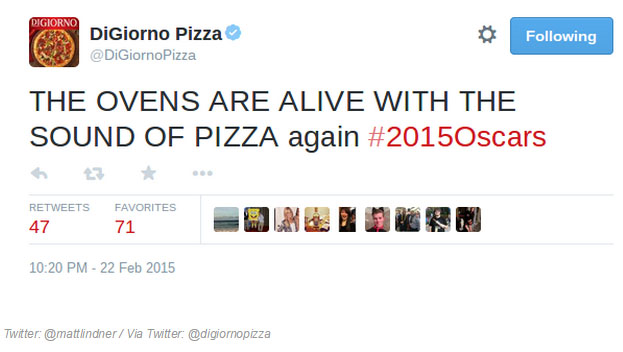
Oreo’s Dunk in the Dark Campaign has had quite an impact on how brand and content marketers use social media during real-time events. The timely and relevant campaign caused brands to feel the need to immediately react to real-time events – even creating “war rooms” prior to known events – in order to be the first to capitalize on a “Dunk in the Dark” moment.
Power out? No problem. pic.twitter.com/dnQ7pOgC
— Oreo Cookie (@Oreo) February 4, 2013
While it is true that real-time marketing can be a successful venture for some brands – Oreo received 525 million media impressions with its famous tweet – this trend is leading to a plethora of brands getting in on the craze. The results are shoehorned content with a focus more on being released in a timely manner, than expanding brand awareness and providing value to consumers. With massive name brands hopping on the “newsjacking” trend, how can a smaller company compete and capitalize on real-time marketing? Let’s take a look at some brand’s successful and failed attempts during the 2015 Academy Awards to find out:
Successful: The Lego Oscar
In response to being snubbed in the Best Director and Best Picture category, The Lego Movie’s Director Phil Lord tweeted a picture of a gold trophy made entirely of Legos. During the performance of a song from the film “Everything is Awesome,” members of the Lego team handed out fake Oscar awards to influential celebrities in the audience who were also snubbed. Lego was able to spin a negative occurrence into major brand awareness for the company, and while this campaign was preconceived before the actual awards ceremony took place, it shows that any business can capitalize on an event that is timely and not just in real time.
It’s okay. Made my own! pic.twitter.com/kgyu1GRHGR — philip lord (@philiplord) January 15, 2015
Successful: The U.S. Department of Labor
Though it is not technically a brand, the labor sector of the United States’ government was able to get people talking after Patricia Arquette used her acceptance speech as a platform to speak for equal rights and pay for women in America. By tweeting out a picture of Arquette along with an impactful quote from her speech – and a fact from the U.S. Department of Labor that backed up what she said – the department was able to generate buzz and drive traffic to their website. Businesses on a smaller scale can use this technique to drive traffic to their website by tying in real-world news and events into their social advertising campaigns.
FACT: Women make 78% of what their male counterparts make. Learn more: http://t.co/ZUbWdaIJPr #Oscars pic.twitter.com/YyNgF14gRk
— US Labor Department (@USDOL) February 23, 2015
Successful: Apple iPad to Make Films and the Oscars’ Campagin
During the 2015 Oscars, Apple aired a commercial that made quite a statement by claiming the next great film director could be filming an Oscar-worthy movie with an iPad right now. Not only did they choose an opportune moment to display their ad, but Apple simultaneously bundled together different film-making and editing apps that could be purchased in the app store as a special offer.
This was a great example of how companies can use a live event to promote their products and corresponding special promotions across several platforms at once. The marketing team for the Oscars also got in on cross-platform promotion during real-time events by encouraging users to go to the award show’s website to make predictions about who would win, and share their predictions and results across social media outlets.
Small and medium sized business can apply this same approach when utilizing real-time marketing in order to create a big impact with memorable advertisements. By using a live event to base content and special offers around, followers of a business’s social media outlets, post reach, user engagement and the likelihood of making a sale or new customer all increase.
Unsuccessful: DiGiorno’s Short-Lived Tweet
Since there were no “Oreo” or “celebrity selfie” moments at the 2015 Academy Awards, brands were trying create them by posting advertisements related to anything going on during the show. During the Oscars’ tribute to The Sound of Music’s 50th anniversary, the frozen pizza company decided to try and capitalize on a trending hashtag by posting a tweet that read “ THE OVENS ARE ALIVE WITH THE SOUND OF PIZZA again #2015oscars.” The tweet was quickly taken down after many realized it probably wasn’t a good idea to associate a movie about a family fleeing the Nazi rule of Austria during WWII…with an oven that played a detrimental role in the Holocaust genocide.
However, every company using real-time marketing can benefit from DiGiorno’s mistake by realizing the quality matters most when it comes to advertising. The lack of thought that clearly went into the tweet shows how important it is to actually take the time to post quality content in a timely manner. Don’t worry about being the first, worry about being the most impactful. 
Unsuccessful: Barney’s New York
Just because there is a national or worldwide event or news that is currently trending in the social sphere does not mean that every company and brand will be able to capitalize on the trend. Take Barney’s New York for example, who tweeted out a picture of a pair of Givenchy rain boots…just because it was raining on the red carpet.
The connection they tried to make between their brand and the awards show was too much of a stretch and thus was not communicated correctly to followers. Real-time marketing will not be effective if you cannot engage the consumer, make sure you are only posting real-time advertisements that fit your brand accordingly.
3 words: @givenchy rain boots. http://t.co/oHBWnRQLXv RT @mrjoezee…Rain is so not chic. pic.twitter.com/iSCnwiGVrg
— Barneys New York (@BarneysNY) February 23, 2015
#TheDress
Real-time marketing made an abrupt and unbelievable appearance on Feb. 26 when a picture of a dress went viral. To some, the dress appeared to be blue and black, the actual colors of the dress, while others swore it was white and gold – the argument was revealed to be the result of the photo’s lighting. Disagreements of the dress’ color spread like wildfire across every social media platform as people tried to debunk why some people saw one thing while other saw something completely different.
BuzzFeed was the first source to pick up the photo and write an article, which has now been viewed 37,859,711 times. Every brand – big, small and everything in between – got in on the viral sensation to try to capitalize on a real time event to promote themselves and their products. There were multiple hashtags related to the dress trending on nearly every outlet and it seemed like every brand in existence took their best shot at real-time marketing – some successfully, others not so much.
Correct: Pizza Hut
It’s white and gold. pic.twitter.com/OqrPgKx6r4 — Pizza Hut (@pizzahut) February 27, 2015
Correct: Specsavers
For all of you who think #theDress is #WhiteandGold, come and visit us for an eye test #shouldve https://t.co/meL7PikOJu — Specsavers (@Specsavers) February 27, 2015
Correct: Lego
#whiteandgold or #blackandblue? We found a way around science- you can have both! #TheDress #dressgate pic.twitter.com/5oj3ZTqOWk — LEGO (@LEGO_Group) February 27, 2015
Unsuccessful: AT&T
Let’s settle this once and for all, it’s blue and white. #Effortless #TheDress pic.twitter.com/EndigfjSVB — AT&T (@ATT) February 27, 2015
Unsuccessful: Charmin
We’ve been asked… The dress is blue & black. #tweetfromtheseat — Charmin (@Charmin) February 27, 2015
Unsuccessful: M&M’s
Why does everyone keep calling us Gold and White now? What’s going on, Internet?! #TheDress #WhatColorsAreThisDress pic.twitter.com/Hz4xGr7DzZ — M&M’S® Brand (@mmschocolate) February 27, 2015
Aftermath:
The company that created the dress, Roman Originals, even took to twitter and used the debate to increase revenue and awareness by ensuring consumers that the dress in the photo is blue and black and that it is back in stock. There are even rumors floating around that the dress will soon be offered in white and gold! According to The Daily News, Roman Originals sold out of the dress within 30 minutes the day after #TheDress broke on social media and website traffic has increased by 2000%
We can confirm #TheDress is blue and black! We should know! http://t.co/qAeIIHzJxk pic.twitter.com/kkxjUbmgI3 — Roman Originals (@romanoriginals) February 27, 2015

